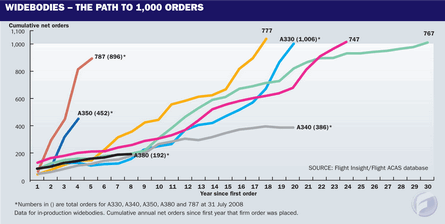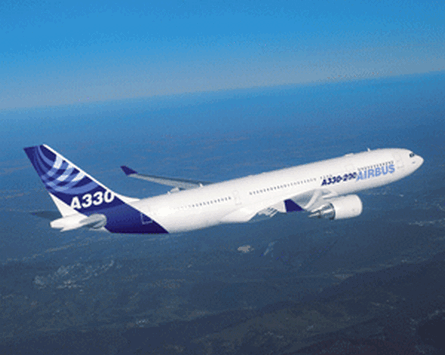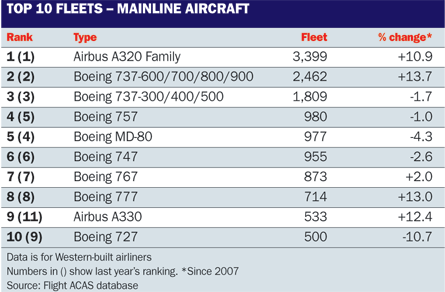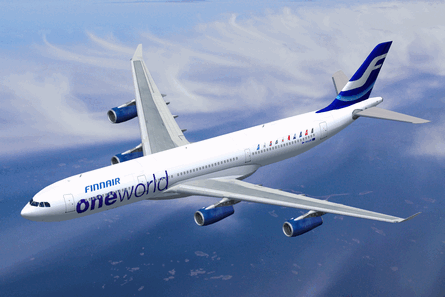There were contrasting fortunes for the executives in Toulouse last month. As Airbus chief salesman John Leahy and his team celebrated the A330 twinjet's passing of the 1,000-order mark, the Sun was setting on its four-engined sister, the A340-300, as the final airline delivery was completed.
The A330 becomes only the second Airbus type to reach the 1,000 order milestone (the single-aisle family passed it in 1994), and only the fourth widebody to see sales reach four figures. All the others are Boeings, with the 747 having for many years been the only twin-aisle airliner to break the threshold until it was joined by the 767 and 777 last year. However, the record-breaking 787 - in sales terms if not development timing - is just 100 aircraft short of the "one-k" mark.
Launched as a pair 21 years ago last June, the A330 and A340 have been marketed since day one as a family of widebodies. Such is the strength of that marketing line that even 20 years on Airbus has so far appeared reluctant to crow about the important order milestone for the A330, as it would argue that sales passed that point two years ago when combined with those of its sister, the A340.
 |
|---|
When the programme was launched, it was the CFM International CFM56-powered A340-200/300 quadjet that was the lead model in the development programme and should really have been called "A330". However, as one Airbus executive once quipped: "Our customers would have had a hard time getting their heads around the fact that our four-engined model was called 'A330' and our twinjet 'A340'."
Although the A330's sales were a match for the A340 in the early days, it initially had a very narrow sales campaign pitched at the high-capacity "short/medium-haul" market. The A330's brief cameo for launch customer Air Inter saw it operate as a 412-seater on French domestic services - until competition from the high-speed train intervened.
Meanwhile, the A330's four-engined sister went down the "long, thin route", aiming to grab the McDonnell Douglas DC-10-30 replacement market as well as capturing growth in those markets as deregulation drove international network expansion.
 |
|---|
© Airbus |
But Boeing had an ace up its sleeve with the 767-300ER, which would evolve into an effective 11,500km (6,250nm)-range/260-seat twinjet, while Airbus tried to convince airlines that four engines were better than two for missions longer than 8h.
Then along came the 777, which reinforced Boeing's "big-twin" argument and forced Airbus to relent and reconsider its strategy. The result was the A330-200 "shrink" - the first Airbus twinjet with genuine 11,800km range. Launched in 1995, the model transformed the aircraft's appeal - so much so that some Airbus executives quietly wondered why they had not done it sooner. More capable versions of the A330-300 followed as well as an all-cargo -200 derivative, as Airbus refocused its four-engined marketing effort on the larger A340-500/600 family.
 |
|---|
"The A330, like Airbus's second best-selling twin-aisle family, the A300/A310, has prospered due to international route fragmentation - a lesson it ignored with the A380 launch decision," says Richard Aboulafia, vice-president analysis at Teal Group. The tardy, but ultimately well-conceived A330 range development effort enabled the Airbus to "leapfrog the 767", says Aboulafia.
Ironically, the strength of Airbus's response forced Boeing to develop the all-new 787 when it become obvious that it could not counter the A330 with 767 derivatives such as the stillborn "-400ERX".
And while the A350 was undergoing countless redesigns to ensure it would be a long-term competitor to the Dreamliner, Airbus's near-term marketing strategy for the A330 paid off with sales exceeding 500 aircraft over the past four years.
"The success since 2004 has been primarily due to the uncertainty surrounding what the A350 would be and when it would be produced," says Stephen Rimmer, chief executive of A330-200F launch customer Guggenheim Aviation Partners. "Airbus has been particularly aggressive and successful in marketing the A330 as an interim aircraft to the A350."
Rimmer adds that "more recently the A330 has also benefited from the delays in the 787", while Aboulafia points out that "much of the latest round of A330 transactions is related to 787 penalty payments".
 |
|---|
© Finnair |
As monthly A330 production heads towards 10 a month, output of the A340 is averaging just one. On 31 July, the last of 245 A340-200/300s built was delivered to Finnair (one aircraft remains on backlog for a VIP customer), and Airbus has yet to notch up a single sale for the Rolls-Royce Trent 500-powered A340-500/600 this year. The backlog stands at just 31 aircraft.
"The A340-300 was underpowered, heavy and slow, and while the A340-600 addressed some of these issues it has suffered in a rising fuel environment from the four-engine syndrome," says Rimmer. "In today's market this significant disadvantage is very difficult to overcome - even with aggressive pricing."
Source: Flight International























